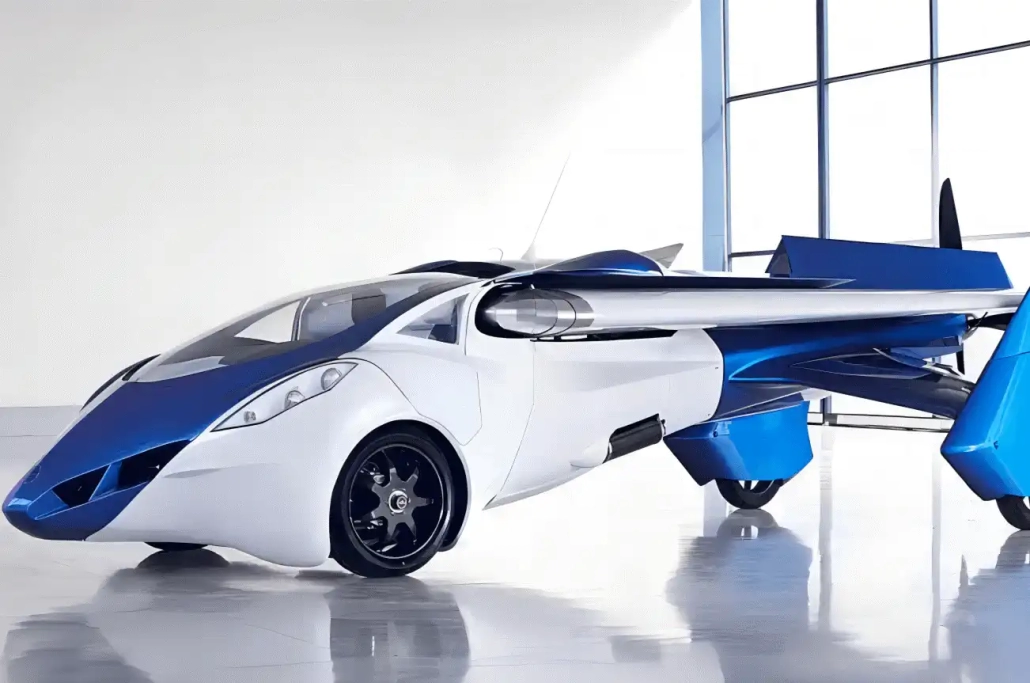Flying Cars: The Game-Changing Innovation of 2024
Table of Contents
- Flying Cars: The Game-Changing Innovation of 2024
- Understanding Flying Cars: A Simple Explanation
- Flying Cars: From Dreams to Reality!
- 7 Key Flying Cars Shaping Tomorrow
- Model A: The Future of Flying Cars Unveiled
- A New Era: Flying Cars Get the Green Light
- The Future of Flying Cars: Excitement and Concerns
- The Power Challenge: What Flying Cars Need to Soar
- Flying Cars: The Next Big Leap in Global Transportation
- Conclusion:
- FAQs:
- Learn More About Battery
In the annals of human ingenuity, the dream of cars taking to the skies has captivated our imaginations for decades. Once a staple of science fiction and futuristic fantasies, flying cars are now transitioning from mere dreams to tangible reality. With the rapid advancements in technology and innovation, spearheaded by companies across the globe, we are on the cusp of an aerial revolution. This evolution isn’t just about defying gravity; it represents a seismic shift in how we view transportation, mobility, and urban development. As we delve into this topic, we’ll explore how these flying marvels, aptly termed “Flying Cars,” are poised to reshape the world as we know it.
Understanding Flying Cars: A Simple Explanation
I’m involved in the fascinating world of flying cars. Yes, you read that right – flying cars! While it’s not a common field, these cars are becoming more real every day. There’s a lot of wrong information out there, so let me clear things up. A flying car is basically a mix of a helicopter and an airplane. It has parts from both, making it really unique.
The Magic of Rotary Wing Aircraft
Rotary wing aircraft, like helicopters, are amazing because they can take off and land straight up and down. This is great because you don’t need a runway. They’re also easy to control and can hover in one spot, which is perfect for cities. But, they do have some downsides like using a lot of energy, being slower than planes, making a lot of noise, and needing skilled pilots for emergencies.
The Power of Fixed-Wing Aircraft
Now, let’s talk about fixed-wing aircraft, or what we usually think of as airplanes. They are fast and efficient, flying long distances while carrying more stuff. If something goes wrong, they can still glide and land safely. However, they need long runways for takeoff and landing and can’t hover in one place.
Combining the Best of Both Worlds
Flying cars blend the best parts of helicopters and airplanes. They can take off and land anywhere, like a helicopter, but are also fast and can go far, like a plane. They’re not perfect, as they still have some noise and weight issues, but they’re a big step forward in how we think about traveling.
Flying Cars: From Dreams to Reality!
People have always dreamed of flying in the sky. Especially when traffic is bad during rush hours, many wish their cars could fly.
Recently, a company in the U.S. called Alef Aeronautics, funded by Elon Musk, showed their flying car, the Model A, at a car show in North America. They said they’ve got 2,500 orders already. On October 18th, another company that makes flying cars, called EHang, got a special permit for their eVTOL flying car. They teamed up with a city in China to make more flying cars. All this good news means flying cars are becoming more real.
7 Key Flying Cars Shaping Tomorrow
Soon, flying cars might be a common sight in the sky. Companies worldwide are working hard to lift travelers above traffic jams. It’s not just a practical solution; it’s also a super cool way to travel.
The Exciting PAL-V Liberty
The Liberty Sport, priced at $300,000 from the Netherlands-based company PAL-V, is nearing its final testing phase. This three-wheeled car can transform into a gyroplane for two people in under five minutes. On the road, it zooms from 0 to 60 mph in less than nine seconds, with a maximum speed of 100 mph. In the air, it can travel up to 310 miles, but needs a short airstrip for takeoff.
Samson’s Innovative Switchblade
Oregon’s Samson Sky offers the Switchblade, a $170,000 flying car that doubles as a three-wheeled, street-legal vehicle. In less than three minutes, its wings and tail expand for flight. The Switchblade, classified as an Experimental Category aircraft, requires owners to build most of it themselves. Deliveries are expected in 2025.
Aska A5: The Drive and Fly eVTOL
California’s Aska presents the A5, claiming it to be the first drive-and-fly eVTOL. About the size of an SUV, the hybrid-electric A5 uses six propellers for vertical takeoff. It can fly 250 miles at 150 mph and drive up to 70 mph on highways. Aska plans to release the A5 to the market by 2026.
Klein Vision’s AirCar: A Blend of Luxury and Technology
The AirCar, with a price range of $500,000 to $1 million, resembles a futuristic hypercar. Developed by Slovakia’s Klein Vision, it transforms from a stylish roadster to a two-passenger aircraft at the press of a button. Klein Vision is working on getting European certification.
Alef Model A: The New Face of Flying Cars
Alef’s Model A, priced at $300,000, is unique with its street-legal driving and vertical-takeoff features. Seating two passengers, this all-electric vehicle can travel 200 miles on the road and 110 miles in flight. Production is set to begin in the first quarter of 2025.
Doroni H1: Easy-to-Fly Electric Aircraft
Miami’s Doroni is designing the H1, an electric aircraft that’s simple to fly. Classified as a Light Sport Aircraft, it will be available to anyone with a driver’s license and some training. The H1, with a range of 50 miles and a top speed of 140 mph, is expected to hit the market in 2024.
Maverick: The Off-Road Flying Car
Florida’s I-TEC Education Center offers the Maverick, a unique flying car ideal for off-road adventures. This buggy-like vehicle, which also functions as a paraglider, is already on the market. It’s designed to fly over challenging terrains and can go from 0 to 60 in just 3.9 seconds on the road.
Model A: The Future of Flying Cars Unveiled
Flying cars could solve city traffic problems. Besides that, they can also be used in tourism, deliveries, and medical emergencies. Because of this, the government and businesses have been supporting them a lot.
Recently, at the 2023 North America Car Show, a company called Alef Aeronautics showed their flying car, the Model A. This car looks cool and can do many things. The Model A can drive on roads like a normal car, but if you get stuck in traffic or need to fly, you just push a button, and it takes off. It can fly over busy streets and obstacles. Inside, it has a round cockpit that gives a great view all around. The price? $300,000.
When we talk about flying cars, there are two main types. The first type is cars that people can ride in. The second type includes cars that can carry things like packages. To put it simply, all these flying vehicles, including drones that carry things, are part of the “low-altitude economy.” They’re helping grow this new way of doing business.
A New Era: Flying Cars Get the Green Light
Like many new things, flying cars have faced challenges in getting approved by government agencies. However, good news is here! In July, Alef Aeronautics’ flying car, the Model A, was given a special certificate by the U.S. Federal Aviation Administration. This means it’s the first car that can both fly and drive on roads approved by this U.S. agency. Recently in China, a company called EH Intelligent Equipment got a certificate for their EH216-S drone from the Chinese Civil Aviation Authority. This shows that their drone meets all the required safety standards. Another company, Volante, is now starting the process to get their VE25-100 flying vehicle approved.
Thanks to improving technology and support from governments, flying cars are becoming more popular around the world. They are getting closer to being used for everyday business. Take Alef Aeronautics as an example. If they sell all 2,500 of their flying cars they’ve got on order, they could make $750 million! The company says their flying cars will start being used in the U.S. by 2025.
The Future of Flying Cars: Excitement and Concerns
As companies rush to make electric Vertical Takeoff and Landing (eVTOL) vehicles a reality, there’s a lot of excitement about their potential. But, just like driverless cars, this fast-developing technology raises some worries. Will we be ready for the changes flying cars bring?
Safety: The Top Priority for Flying Cars
Safety is crucial when it comes to flying cars. Companies are working hard to ensure these vehicles can fly reliably. Plus, there’s the need to make sure passengers and their stuff don’t impact how the eVTOL works. The FAA is already setting up training rules for eVTOL pilots, and these will evolve as the tech gets more common.
Adapting Infrastructure for Flying Vehicles
If flying cars become everyday sights, our cities and towns will need some updates. For example, we’ll need many “vertiports” – places where these cars can take off and land. This means adding helipads to buildings and preparing open lands for takeoffs and landings. Also, we’ll have to figure out where these vehicles can fly without hitting buildings or power lines.
Insurance: A New Challenge for Flying Cars
Insuring eVTOLs is a big question. These flying cars are expensive, and that means their insurance could be pricey too. It’ll be interesting to see how different states handle this and if car insurance companies will start special branches for eVTOLs. Right now, it’s hard to guess how this insurance scene will shape up.
Addressing Inequality in the Age of eVTOLs
Flying cars could also impact social equality. Kevin DeGood from the Center for American Progress worries that they could increase the gap between the rich and the poor. Initially, only wealthy people might afford these cars or their travel costs. If the government supports projects that only benefit the rich, it could worsen economic differences in the U.S. DeGood suggests using eVTOL tech to improve public transportation for everyone instead.
The Power Challenge: What Flying Cars Need to Soar
Flying cars need to be special to fly in the sky. They need a good design and a lot of power. More than what regular electric cars have. The batteries for flying cars must be really strong. They need new kinds of batteries that can hold a lot of power and last a long time. Right now, most car batteries can only power a flying car for a short trip. If they were bigger, the flying car would be too heavy. That’s why experts are trying to make better batteries that are light but still very powerful.
Also, flying cars face many weather challenges. In the summer, the sky can be really hot. In the winter, it can be super cold. Regular car batteries might not work well in these conditions. So, flying cars need batteries made from new materials and with new technology to handle all kinds of weather.
Flying Cars: The Next Big Leap in Global Transportation
Flying cars have a bright future. Because of this, many companies are trying to make better batteries for them. The CATL company in China is working on a new kind of battery for flying cars. They’re teaming up with aviation companies to do this. In the U.S., the SolidEnergy Systems company in Massachusetts made a big lithium battery. It’s one of the biggest batteries of its kind in the world. They’re testing it in flying cars now. Experience Unmatched Power with MANLY Battery: Our lightweight lithium batteries are designed for long-lasting performance. Enjoy peace of mind with our 10-year warranty and personalized customer services. Click to power up your life with MANLY Battery!
Many countries see the value in flying cars. Countries like the U.S., the UK, Germany, Japan, and South Korea see flying cars as important for their future. Reports say China will be a big player in the flying car market, maybe owning about 30% of it.
In a few years, we might see flying cars everywhere in the city sky. They could make travel fast, easy, and smart. It would be like having a new way to travel above the streets.
Conclusion:
In summary, the age of Flying Cars is no longer a distant dream but an impending reality. With giants in the automotive and aviation sectors investing time, resources, and innovation, our skies are set to be transformed in the coming years. The convergence of technology, policy support, and market demand is driving this phenomenal shift. As companies vie to be at the forefront of this revolution, and as countries strategically position themselves to capture significant market share, we stand at the precipice of a new era in transportation. The horizon looks promising, and as Flying Cars become more prevalent, our commute narratives will undoubtedly be stories of the skies. As we hover on the brink of this new age, one thing is clear: the future is up in the air, and it’s electrifyingly exciting!
FAQs:
How Much Will Flying Cars Cost?
The cost of flying cars, specifically the Helix eVTOL from Pivotal (formerly Opener), starts at $190,000. This single-seater aircraft, shaped like a sideways H, boasts a top speed of 62 mph and a range of 20 miles. Charging varies from 75 minutes to 4.5 hours depending on the model. Orders begin on January 9, 2024, with a 25% down payment, and deliveries are set to start on June 10, 2024. Additional costs for options like a transport trailer and fast charging will be announced later.
Will There Be Flying Cars in 2025?
Yes, there will be flying cars in 2025. Alef Automotive’s “Model A,” the first fully electric vehicle approved by the Federal Aviation Administration for testing, is both flyable and road-worthy. Expected to carry 1-2 occupants, it boasts a 200-mile road range and a 110-mile flying range. Sales are projected to start by the end of 2025, with each unit priced at $300,000.
Are Flying Cars Road Legal?
Yes, flying cars can be road legal. Samson Sky’s Switchblade is a notable example. This hybrid-electric flying car, capable of transforming into a road-legal vehicle in under three minutes, successfully completed its first flight in Washington State on November 9th, 2023. With about 2,300 reservations from 57 countries, the Switchblade’s successful maiden flight indicates progress towards production for road and air use.






